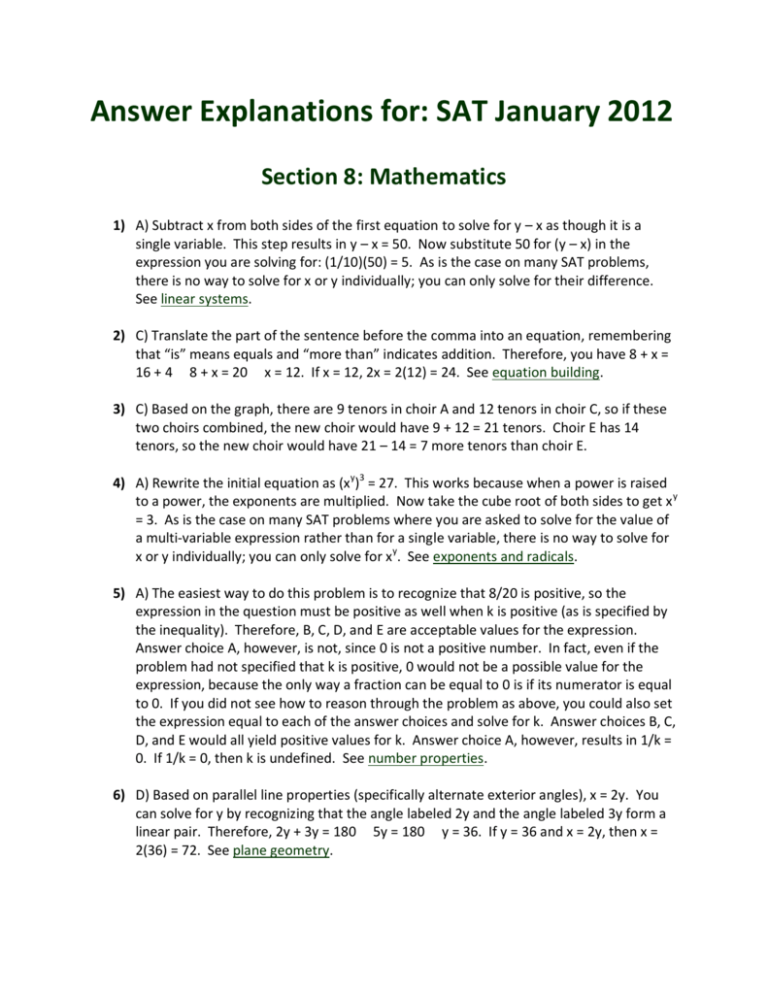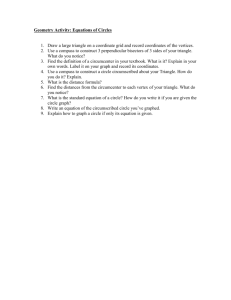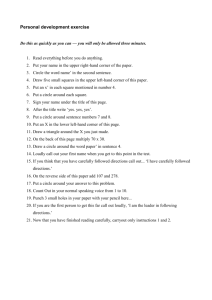Answer Explanations for: SAT January 2012 Section 8
advertisement

Answer Explanations for: SAT January 2012 Section 8: Mathematics 1) A) Subtract x from both sides of the first equation to solve for y – x as though it is a single variable. This step results in y – x = 50. Now substitute 50 for (y – x) in the expression you are solving for: (1/10)(50) = 5. As is the case on many SAT problems, there is no way to solve for x or y individually; you can only solve for their difference. See linear systems. 2) C) Translate the part of the sentence before the comma into an equation, remembering that “is” means equals and “more than” indicates addition. Therefore, you have 8 + x = 16 + 4 8 + x = 20 x = 12. If x = 12, 2x = 2(12) = 24. See equation building. 3) C) Based on the graph, there are 9 tenors in choir A and 12 tenors in choir C, so if these two choirs combined, the new choir would have 9 + 12 = 21 tenors. Choir E has 14 tenors, so the new choir would have 21 – 14 = 7 more tenors than choir E. 4) A) Rewrite the initial equation as (xy)3 = 27. This works because when a power is raised to a power, the exponents are multiplied. Now take the cube root of both sides to get x y = 3. As is the case on many SAT problems where you are asked to solve for the value of a multi-variable expression rather than for a single variable, there is no way to solve for x or y individually; you can only solve for xy. See exponents and radicals. 5) A) The easiest way to do this problem is to recognize that 8/20 is positive, so the expression in the question must be positive as well when k is positive (as is specified by the inequality). Therefore, B, C, D, and E are acceptable values for the expression. Answer choice A, however, is not, since 0 is not a positive number. In fact, even if the problem had not specified that k is positive, 0 would not be a possible value for the expression, because the only way a fraction can be equal to 0 is if its numerator is equal to 0. If you did not see how to reason through the problem as above, you could also set the expression equal to each of the answer choices and solve for k. Answer choices B, C, D, and E would all yield positive values for k. Answer choice A, however, results in 1/k = 0. If 1/k = 0, then k is undefined. See number properties. 6) D) Based on parallel line properties (specifically alternate exterior angles), x = 2y. You can solve for y by recognizing that the angle labeled 2y and the angle labeled 3y form a linear pair. Therefore, 2y + 3y = 180 5y = 180 y = 36. If y = 36 and x = 2y, then x = 2(36) = 72. See plane geometry. 7) B) The total number of people who purchased items at the department store is equal to 85 + 155 = 240. To find the number of people who purchased clothing, take 40% of 240: .4 • 240 = 96. The number of women who purchased clothing is equal to the number of people who purchased clothing minus the number of men who purchase clothing, so 96 – 42 = 54. See percentages. 8) A) Remember that an absolute value (symbolized by the pairs of vertical lines in the inequality) has the effect of making whatever is inside of the absolute value positive. Therefore, you can solve this problem by looking at each ordered pair, making any negative values positive, and then adding the two positive values together. If the result is greater than 5, the ordered pair does not satisfy the inequality. The only ordered pairs that do not satisfy the inequality are therefore (5, -1) since 5 + 1 = 6, (-1, 5) since 1 + 5 = 6, and (0, 6) since 0 + 6 = 6. Because Set I is the only set for which every ordered pair satisfies the inequality, the correct answer is A. See absolute values. 9) C) Call the fourth term of the sequence a4 and the sixth term of the sequence a6. To find a6, set up the following equation based on the information in the question, remembering that “less than” means is subtracted from and “twice” means 2 times: a 6 = 2(17) – 3 = 31. To find the a4, set up a similar equation: 17 = 2(a4) – 3 20 = 2(a4) a4 = 10. Since a4 = 10 and a6 = 31, the sum of these terms is 10 + 31 = 41. See series and sequences. 10) E) When calculating the probability of one event OR another event occurring, add the individual probabilities of each event occurring. In this case, you have 3/5 + 1/5 = 4/5. See counting and probability. 11) E) It is probably a good idea on this problem to draw points A and B so you can visualize them. It is also helpful to label the lengths of line segments with numeric values that fit the requirements of the problem: let AP = 3 and PB = 1. Because AB is composed of AP and PB, AB = 3 + 1 = 4. Therefore, the ratio of AB to PB is 4 to 1. If you answered A, you likely understood the problem correctly but got the ratio backwards. If you answered D, you found the ratio of AP to PB. See ratios and proportions. 12) B) The easiest way to do this problem is to visualize triangle AQB and triangle DSC combining to form a square. This square would have a side length equal to half the side length of the large square (square PQRS) and would therefore have an area equal to 1/4 that of the large square. (If it is not intuitive that the small square has an area equal to ¼ that of the large square, you could calculate it mathematically. If the large square has an area of z, then its side length is equal to √ . Since the small square has sides half the length of those of the large square, its sides have length .5√ . Therefore, its area is equal to (.5√ )2 = .25z, which is 1/4 the area of the large square.) If 1/4 of the large square is unshaded, then 3/4 of it is shaded, so the shaded region is equal to (3/4)z. The problem could also be done without combining the two triangles into a square (although this way is more complicated). If the large square has an area of z, then its side length is equal to √ . Each unshaded triangle is a right triangle with both legs equal to half the side length of the square, so both legs are equal to .5√ . In a right triangle, the two legs can be considered the base and the height, respectively, when calculating the area. Therefore, the area of each triangle is equal to (1/2)( .5√ • .5√ ) = 1/2(.25z) = (1/8)z. Because there are two such triangles, their total area is equal to 2* (1/8)z = (1/4)z. Subtract this value from z, the area of the square, to get the area of the shaded region: z – (1/4)z = (3/4)z. See plane geometry. 13) B) If x is even, then x plus any even number is also even, since an even plus an even is always even. Therefore, x + 4, x + 6, x + 8, x + 10, and x + 12 are all even, a total of 5 even integers. You could have also done this problem by choosing any even number for x and finding the even numbers between x + 3 and x + 13. For instance, if you let x = 4, then x + 3 = 7 and x + 13 = 17. The even numbers between 7 and 17 are 8, 10, 12, 14, and 16, a total of 5 even integers. See number properties. 14) D) Create two equations based on the information in the problem. Let u be the credits she earned at the state university and c be the credits she earned at the community college. Based on the first sentence of the problem, you can write the following equation: u = c + 35. Based on the second sentence of the problem, you can write the following equation: .5u = 3c. The easiest way to solve this system is via substitution. Because u = c + 35, you can substitute c + 35 for u in the other equation to get .5(c + 35) = 3c .5c + 17.5 = 3c 17.5 = 2.5c c = 7. Plug 7 into either of the two equations for c and solve for u. u = 7 + 35 = 42. Therefore, she earned 7 credits at the community college and 42 credits at the state university, a total of 7 + 42 = 49 credits. See equation building and linear systems. 15) E) The easiest way to do this problem is visually. Since the distance from the center point to the y-axis (8) is less than the circle’s radius, the circle will intersect the y-axis in two points. Likewise, since the distance from the center point to the x-axis (9) is less than the circle’s radius, the circle will intersect the x-axis in two points. Because the center point is not exactly 10 units from the origin (0, 0) (the Pythagorean Theorem can confirm this), neither of the points where the circle intersects the x-axis is also a point at which it intersects the y-axis. Therefore, the circle intersects the axes at 4 unique points. If you have difficulty visualizing the circle as described above, you can also solve this problem algebraically. Standard form of a circle is (x – h)2 + (y – k)2 = r2 where (h, k) is the center point and r is the radius. Therefore, the equation of this circle is (x – 8)2 + (y – 9)2 = 100. The circle will intersect the x-axis when y = 0, so you can solve for these points by substituting 0 for y: (x – 8)2 + (-9)2 = 100 x2 – 16x + 64 + 81 = 100 x2 – 16x + 45 = 0. Use the quadratic formula or solve graphically by graphing and finding the xintercepts to get x = 12.36 and x = 3.64. Therefore, the circle intersects the x-axis (12.36, 0) and (3.64, 0). Now you must find the points where the circle intersects the yaxis. The circle will intersect the y-axis when x = 0, so you can solve for these points by substituting 0 for x: (-8)2 + (y – 9)2 = 100 y2 – 18y + 81 + 64 = 100 y2 – 18y + 45 = 0 (y – 15)(y – 3) = 0 y = 15 and y = 3. Therefore, the circle intersects the y-axis (0, 15) and (0, 3). This process is time consuming, however. You are much better off visualizing the circle as described above. See circles and quadratics. 16) A) Subtract 2 from both sides of the first equation in the question to get f(b) = g(b) – 2. Therefore, if g(a) = 8, then f(a) = 8 – 2 = 6. If f(a) = 6, then, according to the table, a = -3. See function notation.





